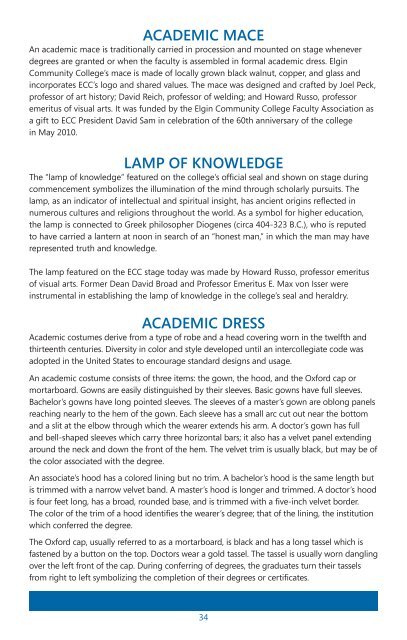Commencement - Spring 2022|Elgin Community College
Spring Commencement Exercises conducted in-person on May 21, 2022.
Spring Commencement Exercises conducted in-person on May 21, 2022.
You also want an ePaper? Increase the reach of your titles
YUMPU automatically turns print PDFs into web optimized ePapers that Google loves.
ACADEMIC MACE<br />
An academic mace is traditionally carried in procession and mounted on stage whenever<br />
degrees are granted or when the faculty is assembled in formal academic dress. Elgin<br />
<strong>Community</strong> <strong>College</strong>’s mace is made of locally grown black walnut, copper, and glass and<br />
incorporates ECC’s logo and shared values. The mace was designed and crafted by Joel Peck,<br />
professor of art history; David Reich, professor of welding; and Howard Russo, professor<br />
emeritus of visual arts. It was funded by the Elgin <strong>Community</strong> <strong>College</strong> Faculty Association as<br />
a gift to ECC President David Sam in celebration of the 60th anniversary of the college<br />
in May 2010.<br />
LAMP OF KNOWLEDGE<br />
The “lamp of knowledge” featured on the college’s official seal and shown on stage during<br />
commencement symbolizes the illumination of the mind through scholarly pursuits. The<br />
lamp, as an indicator of intellectual and spiritual insight, has ancient origins reflected in<br />
numerous cultures and religions throughout the world. As a symbol for higher education,<br />
the lamp is connected to Greek philosopher Diogenes (circa 404-323 B.C.), who is reputed<br />
to have carried a lantern at noon in search of an “honest man,” in which the man may have<br />
represented truth and knowledge.<br />
The lamp featured on the ECC stage today was made by Howard Russo, professor emeritus<br />
of visual arts. Former Dean David Broad and Professor Emeritus E. Max von Isser were<br />
instrumental in establishing the lamp of knowledge in the college’s seal and heraldry.<br />
ACADEMIC DRESS<br />
Academic costumes derive from a type of robe and a head covering worn in the twelfth and<br />
thirteenth centuries. Diversity in color and style developed until an intercollegiate code was<br />
adopted in the United States to encourage standard designs and usage.<br />
An academic costume consists of three items: the gown, the hood, and the Oxford cap or<br />
mortarboard. Gowns are easily distinguished by their sleeves. Basic gowns have full sleeves.<br />
Bachelor’s gowns have long pointed sleeves. The sleeves of a master’s gown are oblong panels<br />
reaching nearly to the hem of the gown. Each sleeve has a small arc cut out near the bottom<br />
and a slit at the elbow through which the wearer extends his arm. A doctor’s gown has full<br />
and bell-shaped sleeves which carry three horizontal bars; it also has a velvet panel extending<br />
around the neck and down the front of the hem. The velvet trim is usually black, but may be of<br />
the color associated with the degree.<br />
An associate’s hood has a colored lining but no trim. A bachelor’s hood is the same length but<br />
is trimmed with a narrow velvet band. A master’s hood is longer and trimmed. A doctor’s hood<br />
is four feet long, has a broad, rounded base, and is trimmed with a five-inch velvet border.<br />
The color of the trim of a hood identifies the wearer’s degree; that of the lining, the institution<br />
which conferred the degree.<br />
The Oxford cap, usually referred to as a mortarboard, is black and has a long tassel which is<br />
fastened by a button on the top. Doctors wear a gold tassel. The tassel is usually worn dangling<br />
over the left front of the cap. During conferring of degrees, the graduates turn their tassels<br />
from right to left symbolizing the completion of their degrees or certificates.<br />
34

















